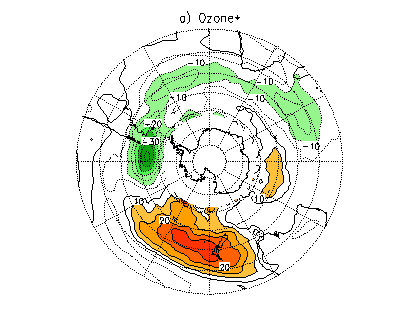
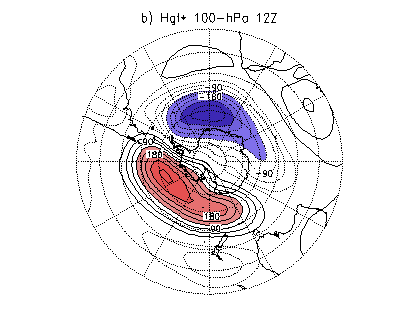
P.K.Vigliarolo1*,
C.S.Vera2, S.B.Díaz1 and W.Ebisuzaki3
1 Austral Center of Scientific Research-CONICET, Ushuaia, Tierra del Fuego, ARGENTINA
2 CIMA/ Dept.of Atmospheric Sciences, University of Bs.As.-CONICET, ARGENTINA
3 Climate Prediction Center, NCEP, Washington D.C.
*Corresponding author address: Paula K.Vigliarolo. CADIC, Ruta 3 y Cap.Mutto s/n. (9410) Ushuaia, Tierra del Fuego, Argentina. Email: paulav@ciudad.com.ar
FIGURES
Abstract
1. Introduction
Since
long ago it has been recognised the relationship between ozone and atmospheric
fields from scales ranging from decadal to interdiurnal. While for the
long time-scales ozone is influenced by the atmosphere and viceversa, from
a couple of weeks to days, ozone variability is mainly attributed to dynamical
effects, as the ozone mixing ratio is a quasi-conserved tracer in the lower-stratosphere
(Andrews et al. 1987). As a consequence, a clear correspondence between
areas of maximum synoptic activity and regions of large ozone fluctuations
is established. The nature of such correspondence may be understood in
terms of baroclinic waves producing horizontal and vertical motions that
affect the ozone distribution, as ozone partial pressure is
maximum in the lower-stratosphere, near the tropopause where this
waves also attain a maximum (Vigliarolo et al. 2000 and references therein).
Therefore, it is of interest to investigate in detail such dynamical-ozone
changes for particular cases. In this paper an extreme ozone event is studied
over southern South America (hereafter SA), a region that reports minimum
winter mean ozone content and moderate to high ozone daily-variability
(Vigliarolo et al. 2000).
2. Data
The dataset is based on 1994 July NCEP four-daily reanalyses of standard meteorological variables given in constant pressure levels ranging from surface to 10-hPa and also over isentropic surfaces in the upper troposphere and lower stratosphere. From 100 to 10-hPa, the vertical velocity field was estimated using the thermodynamic equation under adiabatic conditions. Total ozone data from Meteor 3/Toms (version 7) was also used for the period of study, along with ozone mixing ratio profiles from SBUV/2 NOAA-11 (version 6; for reference see ftp://toms.gsfc.nasa.gov/pub/sbuv/sbuv2/readme.v612 ).
3.
Mean Fields
3.a Stationary
Waves
In
this section the basic structure of stationary waves is discussed. Figure
1a shows ozone stationary component, calculated as the difference between
July 1994 mean field and the corresponding zonal mean (denoted by "*").
South of 50ºS, ozone field depicts the typical wave number 1 that
characterises the winter season, as described by Vigliarolo et al. (2000).
Nevertheless, some differences could be appreciated. The high latitude-strong
negative center is located slightly to the west and north regarding its
climatological position and with values that are about two times greater.
On the other hand, the positive center near 50ºS, 115ºW is much
weaker (about 0.5 times) compared to climatology. Vigliarolo
et al. (2000) have suggested that winter ozone stationary pattern
over middle and high latitudes of Southern Hemisphere (SH) depends critically
on the three dimensional structure of atmospheric stationary waves, which
in turn produce ozone anomalies via both horizontal and vertical transports
(although they also caution about the main role of non-conservative processes
in contributing to ozone pattern).


Figure 1: Zonal asymmetries
of July 1994 mean fields for a) ozone and b) 100-hPa geopotential height.
The contour interval is (a) 5 DU and (b) 50 m and the zero contour has
been omitted.
The
geopotential-height stationary wave at 100-hPa (fig.1b) also shows a wave
number 1 structure over middle to high latitudes. But, although the location
of the geopotential centers roughly coincides with the winter mean position
(see Vigliarolo et al.2000, its fig.2b), the corresponding extremes for
this particular July are more intense (about 1.8 times) and displaced towards
southern SA. In agreement, a westward displacement of the maximum of the
subpolar jet from the Indian Ocean to 45ºS, 15ºW and a jet weakening
along the high latitudes of Pacific Ocean are observed.
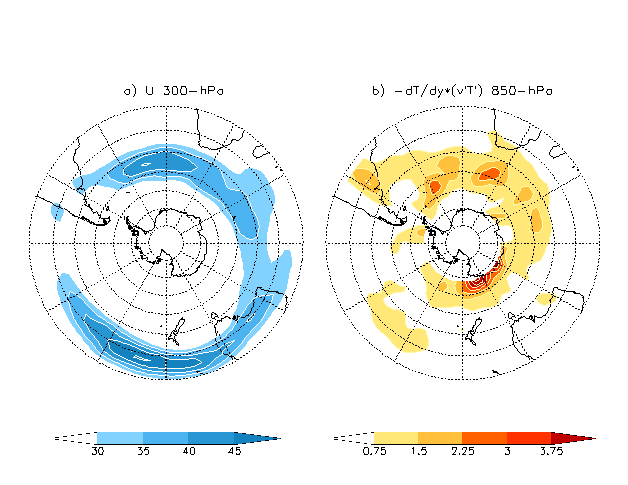
Figure 2: (a) 300-hPa
mean zonal wind (contour interval 5ms-1; only values above 30
ms-1 are shown) and (b) mean ![]() at 850-hPa (contour interval
0.75*104 ºK2 s-1).
at 850-hPa (contour interval
0.75*104 ºK2 s-1).
At
middle latitudes of both southeastern Pacific and Indian oceans, ozone
stationary pattern is related
to geopotential height via the "tropopause effect" (Vigliarolo
et al. 2000 and references therein). Moreover, a nearly continuous band
of negative ozone anomalies centered along 40ºS extends from the Atlantic
to the Central Indian Ocean and is related to geopotential positive anomalies
by the same location; in the Pacific sector, relatively high positive ozone
values are found in connection with a negative geopotential height center
near New Zealand (figs.1a,b).
3.b Transients
The
standard deviation of submonthly perturbations (constructed as the daily
departures from July 1994 time mean) was chosen to represent transient
wave activity. Ozone perturbation standard deviation (fig.3a) shows large
values along the 40º-55ºS-latitude band, that roughly coincides
with maximum 300-hPa geopotential height perturbation standard deviation
maximums (fig.3b), thus confirming the main role of transients on driving
ozone variability (Salby and Callahan 1993). In addition, the high-variability
ozone centers are located poleward and maximize downstream with respect
to the geopotential-height ones (Vigliarolo et al. 2000). Over southern
SA, ozone perturbation standard deviation attains a maximum well above
the mean winter standard deviation values for the region, that is in close
association with a maximum of the geopotential-height standard deviation
located over the same area (fig.3). In agreement, a minimum of ozone over
this region of maximum submonthly wave activity is observed (fig.1a) that
persisted throughout the month in association with a quasi-stationary,
equivalent barotropic ridge centered at 55ºS, 90ºW (Figs.not
shown).
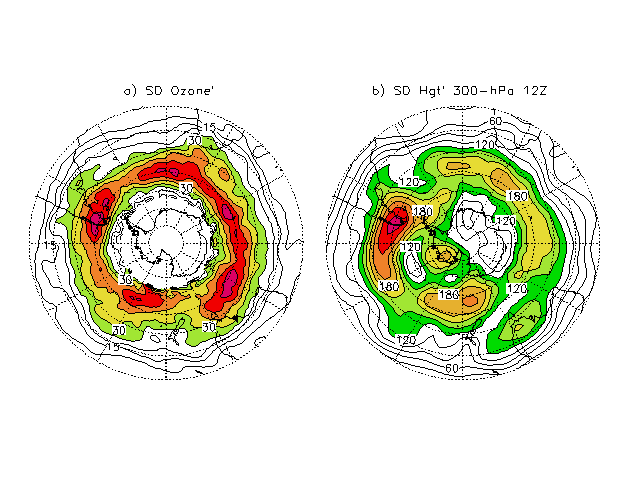
Figure 3: Standard
deviation of daily departures from July 1994 time mean of: a) ozone (contour
interval 5 DU) and b) 300-hPa geopotential height (contour interval 30
m).
Berbery
and Vera (1996) have shown that during austral winter, low level baroclinicity
attains its maximum over the subpolar jet latitudes with the highest values
located between 30º and 60ºE.
The term ![]() (where the overbar denotes time mean and (') is the daily departure from
time means, T is temperature and v is the meridional wind)
is proportional to the mean baroclinic conversion and is shown for the
20º-65º latitude band at 850 hPa (fig.2b). Note that values south
of this boundary are not plotted as it is difficult to assess the quality
of the data around and over Antarctica, where both a combination of high
terrain and steep slopes is found (Berbery and Vera 1996). In general this
field show maximums located further west than the climatology. In particular,
the displacement submonthly scale enhanced activity (fig. 3b) from its
climatological position over the Indian Ocean to the central Atlantic Ocean
seems to be associated with a conspicuous center of high baroclinicity
near 55ºS, 25ºW that extends towards the Antarctica Peninsula
(fig.2b). It is worth to point out that baroclinic conversion is not increased
over southern SA, implying that other dynamical processes not considered
here may account for the transient activity intensification over that region.
(where the overbar denotes time mean and (') is the daily departure from
time means, T is temperature and v is the meridional wind)
is proportional to the mean baroclinic conversion and is shown for the
20º-65º latitude band at 850 hPa (fig.2b). Note that values south
of this boundary are not plotted as it is difficult to assess the quality
of the data around and over Antarctica, where both a combination of high
terrain and steep slopes is found (Berbery and Vera 1996). In general this
field show maximums located further west than the climatology. In particular,
the displacement submonthly scale enhanced activity (fig. 3b) from its
climatological position over the Indian Ocean to the central Atlantic Ocean
seems to be associated with a conspicuous center of high baroclinicity
near 55ºS, 25ºW that extends towards the Antarctica Peninsula
(fig.2b). It is worth to point out that baroclinic conversion is not increased
over southern SA, implying that other dynamical processes not considered
here may account for the transient activity intensification over that region.
4.
Case Study
4.a Synoptic
Evolution
During
the second week of the month, strong ozone perturbations were detected
over southern SA, consisting of a transient ozone wave evolving with a
southwest-northeast direction across the continent. From July 7th
to10th (figs.4a-d) ozone values as low as 240 DU could be followed
along four days from southern Patagonia to southwestern Atlantic. At the
same time, high ozone values (up to 400 DU -fig.4b-) were observed to evolve
over Buenos Aires and to the east.
The
analogous evolution of the atmospheric fields shows a clear correspondence
between ozone relative minimum (maximum) and: ridges (troughs), lowered
(enhanced) tropopause pressure values (figs. 4e-h) and relative maximum
(minimum) of potential vorticity on isentropic surfaces (figs. 4i-l). By
use of a simple conceptual model, Vigliarolo et al. (2000) exhibited the
dynamical relationship between a synoptic wave and the resulting ozone
distribution, provided ozone-mixing ratio is conserved on these time scales.
Moreover they showed by composite analysis for the preferred winter synoptic-scale
mode of variability, that waves evolving along subpolar jet latitudes are
responsible for the corresponding transient ozone-pattern. This is due
to the barotropic-equivalent structure of these waves and the fact that
ozone partial-pressure attains a maximum very close to the level where
these waves also maximise.
In
order to address the relative dynamical contributions of the atmospheric
waves to ozone changes over southern SA region, two approaches are followed.
The first, relates ozone daily changes to horizontal and vertical transports
of ozone mixing ratio by transient motions (subsection 4b), while in the
second ozone distribution is fitted to a multivariate linear relationship
with tropopause pressure and potential vorticity at several isentropic
levels (subsection 4c).
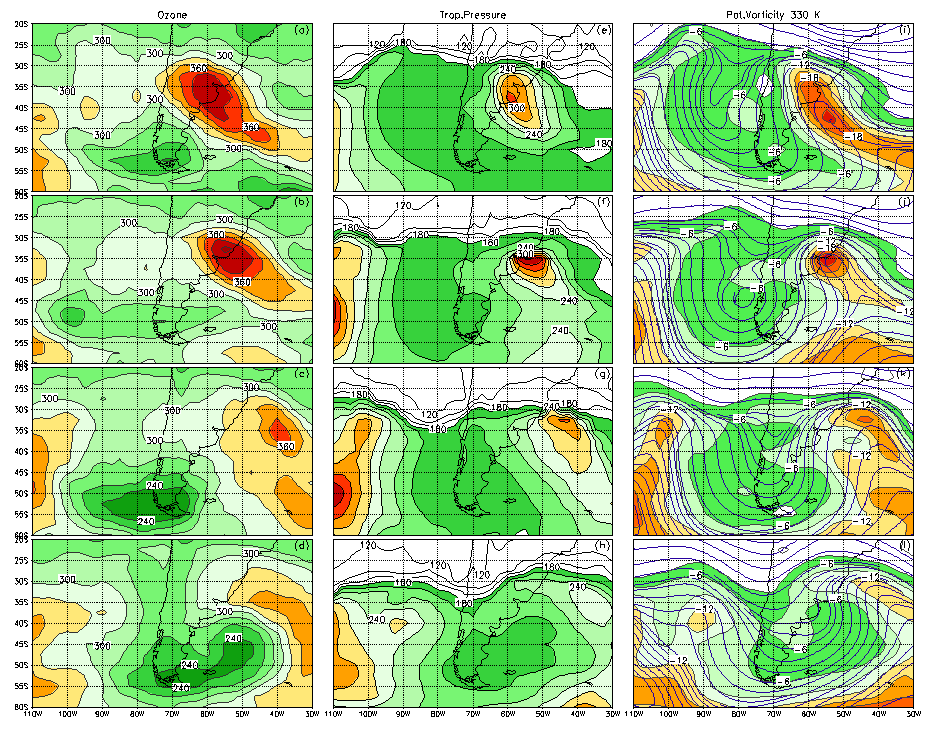
Figure 4: Temporal
evolution from July 7th to 10th of: (a)-(d) ozone,
(e)-(h) tropopause pressure, (i)-(l) potential vorticity (shaded) and streamlines
(thick contours) on the 330ºK surface. Contour interval is (a)-(d)
20 DU; (e)-(h) 20 hPa; and (i)-(j) 2*10-8 m2 s-1
kg-1.
4.b Mapping Technique
A
mapping technique was used to provide estimates of three dimensional ozone-mixing
ratio horizontal gradients based on Meteor 3/Toms total ozone and SBUV/2-
NOAA 11 ozone mixing ratio vertical distribution. This technique allows
meridional ozone mixing ratio estimations supposing a linear relationship
between the former and the meridional ozone gradient. Then, the same derived
linear coefficients are used to estimate zonal ozone mixing ratio gradients
from total ozone zonal gradients. It is worth to note that for July 7th
to 10th, the SBUV/2 profiles used correspond to the scan of
the satellite that passes over the continent, as the subsequent scans are
spread about 25º east and west. Hence, the validity of the above assumptions
is much accurate in a domain close to the satellite path. In addition,
only data from 100 to 30-hPa were used, as above that upper boundary the
dispersion relationship between the "mapped" variables becomes
non-significant.
With
a similar procedure, we also estimate three-dimensional ozone mixing ratio-distribution
in terms of total ozone distribution and SBUV/2 ozone mixing-ratio profiles.
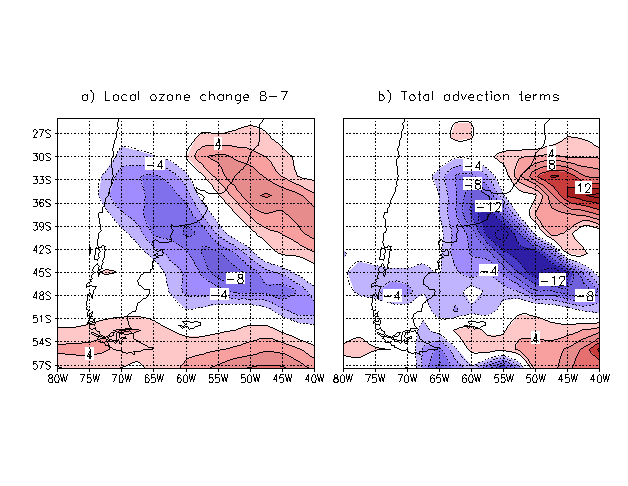
Figure 5: (a) Local
ozone change from July 8th to 7th and (b) total (zonal,
meridional and vertical) advection contributions to ozone changes integrated
over the 100-30 hPa layer. Contour interval 2*10-4 DU s-1,
all zero contours have been omitted.
The
most simple transport ozone equation where the ozone-mixing ratio is conserved
following the motion is:
![]() (1)
(1)
where
![]() stands
for ozone mixing ratio, u and v are the horizontal wind components
and
stands
for ozone mixing ratio, u and v are the horizontal wind components
and ![]() is
the vertical velocity. Then multiplying by the appropriate quantities and
performing a vertical integration of (1), ozone local changes between two
close pressure levels may be obtained as the combined response of both
horizontal and vertical transports of ozone mixing ratio integrated in
the pressure layer.
is
the vertical velocity. Then multiplying by the appropriate quantities and
performing a vertical integration of (1), ozone local changes between two
close pressure levels may be obtained as the combined response of both
horizontal and vertical transports of ozone mixing ratio integrated in
the pressure layer.
In
that sense, local ozone change between July 8th and 7th
is shown in fig.5a while the contributions from zonal, meridional and vertical
(total) advection terms integrated in the 100-30 hPa layer is shown in
fig.5b. Both fields are in good agreement although the total advection
field overestimates ozone local changes by approximately a factor of 1.7.
This may be due to: a) the poor estimates of the vertical velocity field
in the stratosphere, which may be very low compared to the real ones. b)
The limitation of the mapping technique itself for levels above 30-hPa,
although the analysis of SBUV/2 profiles over the region indicate that
the contribution to local ozone changes came from the 125-62.5 hPa layer,
with secondary contributions coming from both 62.5-37 hPa and 250-125 hPa
layers. c) The transports taken only from 100 to 30-hPa, which may be misrepresenting
the real situation.
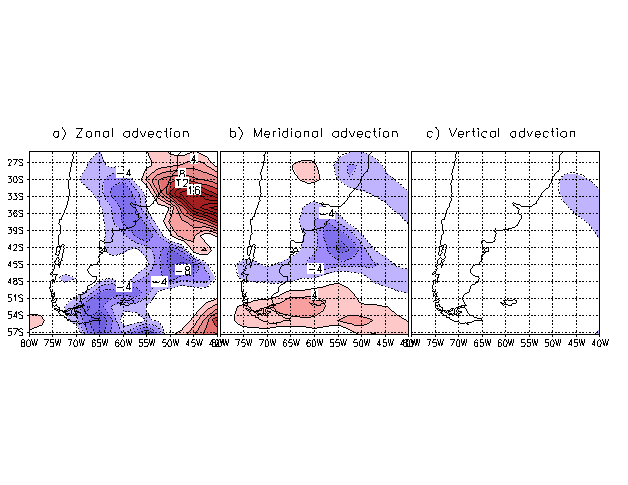
Figure 6: Contribution
to total advection for July 8th to 7th from (a) zonal,
(b) meridional and (c) vertical motion fields; each integrated over the
100-30 hPa layer. Contour interval 2*10-4 DU s-1,
all zero contours have been omitted.
For
the same day, each component of the total advection term integrated over
the 100-30 hPa layer is shown in fig.6. Negative local ozone changes over
the central part of Argentina and extending south-east to the Atlantic
ocean are due to the combined contribution of both zonal and meridional
advection. Meanwhile, the positive ozone changes located to the north of
Uruguay and eastern Atlantic come from the zonal advection term partially
offset by meridional and little vertical advection. To the eastern part
of Tierra del Fuego and over 57ºS, 55ºW too much negative values
are produced by the zonal advection term, although ozone changes over the
region are positive (fig.5a).
4.c Lineal
multivariate regression model
Suggesting
that total ozone variability on synoptic time-scales is mostly explained
by quasi-columnar motion of air
along isentropic surfaces, Salby and Callahan (1993) derived a linear regression
model that relates total ozone content to tropopause pressure and potential
vorticity. In order to test this hypothesis and to find suitable predictors
for ozone distribution, the following relationship was proposed:
![]() (2)
(2)
where
![]() is
total ozone,
is
total ozone, ![]() represents
the tropopause pressure,
represents
the tropopause pressure, ![]() stands
for the potential vorticity on isentropic surfaces of 315ºK, 330ºK
and 450ºK, and
stands
for the potential vorticity on isentropic surfaces of 315ºK, 330ºK
and 450ºK, and ![]() ,
i=0, 4 are the corresponding
regression coefficients.
,
i=0, 4 are the corresponding
regression coefficients.
To
find the regression coefficients that fit the relationship given by (2),
data from the entire month of 1994 July was used according to least square
method. Then, (2) was resolved for the grid points of the SH when the corresponding
time series of the variables involved have no gaps within the month. As
an example, figure 7a shows the time evolution of the relative contributions
from terms in (2) averaged over 35º-55ºS, 50º-70ºW,
an area that encloses the eastern part of southern SA. Contributions from
all terms (tropopause pressure and the sum of potential vorticity contributions)
are in very good agreement with ![]() almost over the whole month, excepting in the period July 25th
to 30th when the differences between each curve become the largest
(about 28 DU). Apart from some few days at the beginning of the month,
potential vorticity remains the main contributor to
almost over the whole month, excepting in the period July 25th
to 30th when the differences between each curve become the largest
(about 28 DU). Apart from some few days at the beginning of the month,
potential vorticity remains the main contributor to ![]() , while an analysis of potential vorticity terms discriminated for isentropic
surfaces (fig.7b) shows that pv315
is the most important term, which in turn is comparable to tropopause
pressure contribution.
, while an analysis of potential vorticity terms discriminated for isentropic
surfaces (fig.7b) shows that pv315
is the most important term, which in turn is comparable to tropopause
pressure contribution.
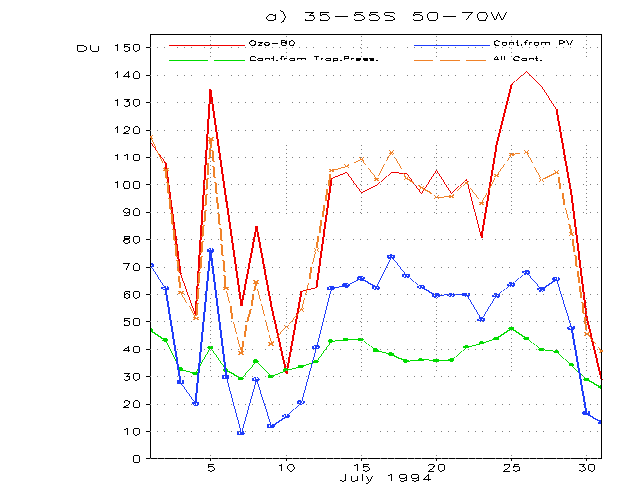
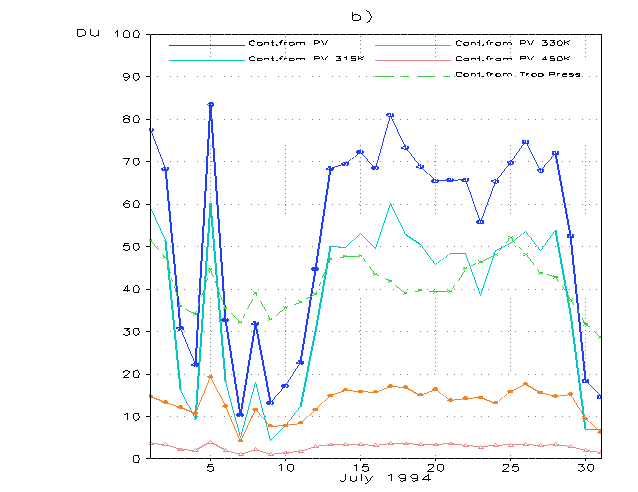
Figure 7: Time evolution
of contributions from the different terms in (2). (a) ![]() is represented by the continuous
curve in red; contribution from tropopause pressure is labelled in green
while that belonging to the sum of all potential vorticity at 315ºK,
330ºK and 450ºK is denoted by blue. The long dashed orange line
represents the sum of all contributions (from tropopause pressure and potential
vorticity). (b) Individual contributions from potential vorticity at 315ºK
(light blue curve), 330ºK (orange) and 450ºK (rose); the sum
of all this contributions are labelled in blue while contribution from
tropopause pressure (green long-dashed) was plotted for comparison purposes.
is represented by the continuous
curve in red; contribution from tropopause pressure is labelled in green
while that belonging to the sum of all potential vorticity at 315ºK,
330ºK and 450ºK is denoted by blue. The long dashed orange line
represents the sum of all contributions (from tropopause pressure and potential
vorticity). (b) Individual contributions from potential vorticity at 315ºK
(light blue curve), 330ºK (orange) and 450ºK (rose); the sum
of all this contributions are labelled in blue while contribution from
tropopause pressure (green long-dashed) was plotted for comparison purposes.
For
July 8th, figure 8 presents: (a) ![]() field, and the contributions from: (b) the sum of potential vorticity from
the three isentropic levels and (c) the tropopause pressure over southern
SA. In particular, over the western Pacific, southern Patagonia and Malvinas
Islands, and the band extending from the continent at 43ºS into the
Atlantic Ocean to the east, relatively low values of the
field, and the contributions from: (b) the sum of potential vorticity from
the three isentropic levels and (c) the tropopause pressure over southern
SA. In particular, over the western Pacific, southern Patagonia and Malvinas
Islands, and the band extending from the continent at 43ºS into the
Atlantic Ocean to the east, relatively low values of the ![]() field are mainly due to decreased tropopause pressure (figs.8c-4f) and
relatively low potential vorticity (figs.8b-4i). On the other hand, high
values of
field are mainly due to decreased tropopause pressure (figs.8c-4f) and
relatively low potential vorticity (figs.8b-4i). On the other hand, high
values of ![]() over north of Uruguay and southeastward over the Atlantic (fig.8a) are
due to relatively low potential vorticity (fig.8b-4I) and tropopause pressure
enhancement (fig.8c-4f) both linked to a cyclone evolution over the area.
over north of Uruguay and southeastward over the Atlantic (fig.8a) are
due to relatively low potential vorticity (fig.8b-4I) and tropopause pressure
enhancement (fig.8c-4f) both linked to a cyclone evolution over the area.
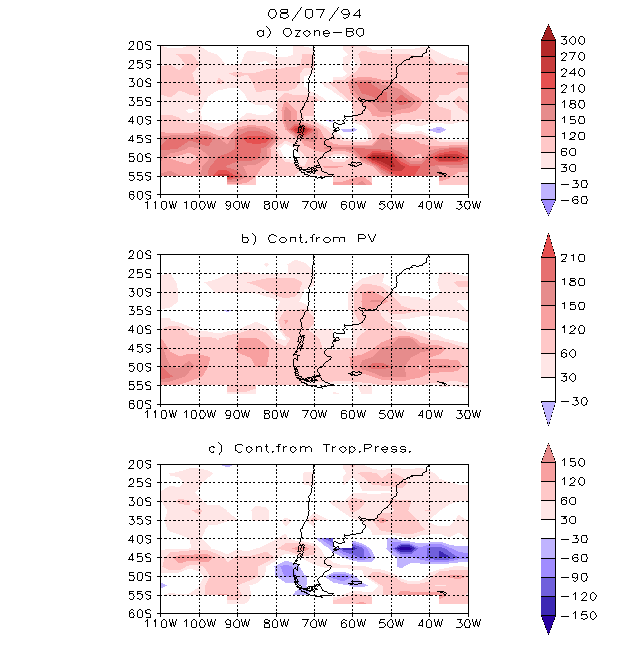
Figure 8: (a) ![]() field, and the contributions
from (b) the sum of terms of potential vorticity from 315ºK, 330ºK
and 450ºK, and (c) tropopause pressure. Contour interval is 30 DU.
field, and the contributions
from (b) the sum of terms of potential vorticity from 315ºK, 330ºK
and 450ºK, and (c) tropopause pressure. Contour interval is 30 DU.
5.
Conclusions
In
this paper, July 1994 extratropical total ozone field is comprehensively
explored over time scales ranging from monthly to synoptic. The structure
of stationary ozone field shows a clear signature of wave number 1 at middle-to-high
latitudes with a minimum well above the climatological mean over southern
SA. This minimum seems to be related to enhanced stationary atmospheric
activity over the region, as well as to a subpolar jet maximum displaced
westward over the southern Atlantic. For middle to low latitudes (up to
25ºS) ozone stationary fluctuations are determined by "tropopause
effect".
Transient
ozone fluctuations were also analysed in relation with upper-tropospheric
wave activity. Mayor zones of standard deviation of ozone daily perturbations
are shown to coincide with the regions of maximum standard deviation of
300-hPa geopotential height perturbations, although the former usually
attain their maximum slightly poleward and downstream. In particular, southern
SA display a maximum of both ozone and geopotential height standard deviation
in association with the presence of a quasi-stationary, equivalent-barotropic
ridge centered near 55ºS, 90ºW.
During
July 7th to 10th a transient ozone wave evolving
along subpolar jet latitudes was modulated and maintained by atmospheric
activity. In order to determine the relative dynamical contributions from
atmospheric waves to ozone distribution two approaches were pursued. Firstly,
ozone local daily changes were explained in terms of a simple ozone transport
equation and by use of the mapping technique. This approach yielded results
that although overestimate local ozone changes, were able to reproduce
comparable spatial patterns. The second approach proposed a multivariate
linear regression model that relates ozone content to tropopause pressure
and potential vorticity on isentropic surfaces. Results suggested that
these quantities are valid predictors for ozone field; the most important
contribution given by the potential vorticity on 315ºK and by tropopause
pressure.
Acknowledgements
The authors are grateful to Dr.W.Randel for his helpful suggestions. Also we would like to thank specially to Dr.L.Flynn from NOAA/NESDIS for providing the SBUV/2 data. This work was partially supported by UBA Grant JX80 and by PICT 07-03781.
References
Andrews, D.G., J.R.Holton, and C.B.Leovy, 1987: Middle Atmosphere Dynamics. Academic Press, Inc. 489pp.
Berbery, H. and C., Vera, 1996: Characteristics of the Southern Hemisphere winter storm track with filtered and unfiltered data. J. Atmos. Sci., 53, 468-481
Salby, M.L., and P.F.Callaghan, 1993: Fluctuations of Total Ozone and Their Relationship to Stratospheric Air Motions. J.Geophys.Res., 98, 2715-2727.
Vigliarolo, P., Vera, C., and Díaz, S., 2000: Southern Hemisphere winter ozone fluctuations. In press at Quart.J.Royal Met.Soc.
Back to
| Session 1 : Stratospheric Processes and their Role in Climate | Session 2 : Stratospheric Indicators of Climate Change |
| Session 3 : Modelling and Diagnosis of Stratospheric Effects on Climate | Session 4 : UV Observations and Modelling |
|
|
|
|
|
|